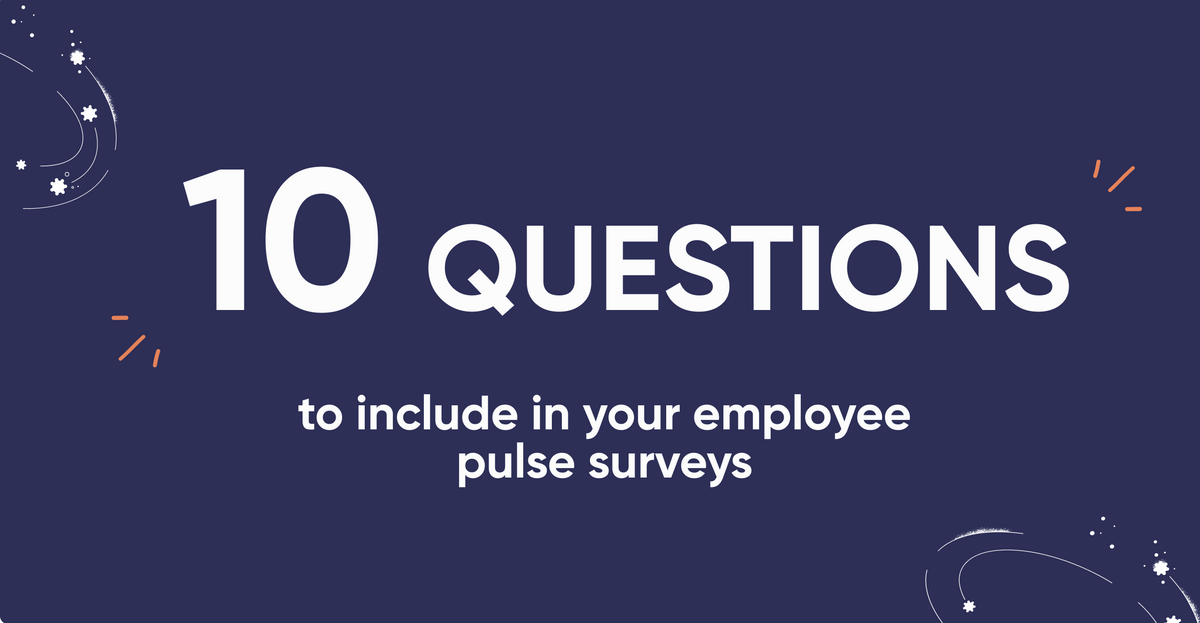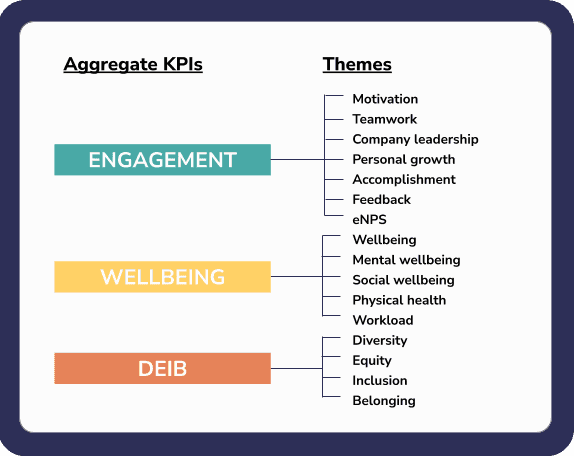Good employee survey questions provide invaluable insights, and most CEOs and People leads know that neglecting them can be very costly. Forerunners are replacing heavy annual/bi-annual surveys with weekly/bi-weekly pulse surveys that allow tracking real-time trends and reacting to issues proactively.
However, as with any problem solving, asking the right questions is what matters.
What those questions are turns out to be less obvious and intuitions can mislead. In this blog post we are shedding some light on the most important themes for employee surveys and questions that yield actionable results.
What is an employee engagement survey?
An employee engagement survey is a focused assessment tool that measures how connected, committed and motivated your employees feel at work. Unlike broader satisfaction surveys, employee survey tools dig deeper into the emotional investment your team members have in your organization's mission and success.
Engagement surveys help you:
- Identify what drives your employees to perform at their best
- Spot potential issues before they lead to turnover
- Create meaningful action plans based on reliable data
- Track improvements in team morale and productivity over time
- Build a workplace where people genuinely want to contribute
How to use employee survey questions?
“What gets measured gets managed.”
This Peter Drucker quote might be a bit cliché, but it applies spot-on to employee surveys. The most important aspects about work and wellbeing depend a lot on the company’s values and culture. These are a good place to start.
For example, how much do we emphasize continuous learning and personal growth? How important are workload balance and mental wellbeing? What is the role of teamwork, dependability, and communication?
Keep in mind that a strong a priori (initial, before data) hypothesis of the organization’s most central issues and strengths might lead to a narrow set of questions that leaves hidden challenges undiscovered. Based on previous scientific research and our customer’s experiences, the following 16 themes provide a versatile “net” that allows identifying different types of organizational and cultural challenges. We have found it useful to categorize these themes under 4 broad areas: Wellbeing, engagement, DEIB, and leadership to calculate a top-level KPI for each:
25 valuable employee survey questions
After you have decided what to measure, the next step is formulating the questions in a way that guarantees actionable insights and minimizes ambiguity. The answer alternatives are just as important as the questions themselves.
It might be tempting to ask open questions with a text response field. However, these raise the mental threshold of answering, which lowers response rates and also makes aggregating data and following trends harder. It’s a safer solution to allow adding optional comments to multiple-choice questions.
A complete picture will require investigating most themes from multiple angles with different questions. Teamspective’s pulse surveys dig deeper into the nuances with 1-13 employee survey questions for each theme. Questions are rotated automatically, so a very broad perspective is gathered over each quarter, while a maximum of 6 questions need to be answered at once. The “traditional” HR software approach of asking dozens of questions at once is burdensome for respondents. We have found that response rates drop sharply after the 6th question.
As a bonus, rotating questions make answering interesting and thought-provoking, instead of becoming a tedious, repetitive chore. You can also add custom questions if something crucial to your company is not covered by the standard set of 61.
Let's look at 25 core questions and their implications:.
Wellbeing
- "How are you feeling at work?" Answer scale: "very bad" to "very good" Theme: Mental wellbeing Implication: Mental wellbeing directly impacts absenteeism and employee turnover. According to the World Health Organization (2022), approximately 12 billion working days are lost annually to depression and anxiety, costing about US$1 trillion in lost productivity.
- "How is your workload?" Answer scale: "way too small" to "way too heavy" Theme: Workload balance Implication: Workload issues often vary by team and strongly influence employee turnover. Our data shows employees considering resignation are 580% more likely to report heavy workloads.
- "Do you feel you have enough time to recover from work during evenings and weekends?" Answer scale: "never" to "always" Theme: Work-life balance Implication: Recovery time prevents burnout and maintains long-term productivity. Without adequate recovery, even motivated employees eventually face performance drops and health issues.
- "How often do you feel stressed at work?" Answer scale: "never" to "always" Theme: Stress management Implication: Persistent workplace stress decreases cognitive function and decision-making quality, directly affecting business outcomes and innovation capacity.
- "How supported do you feel when facing work challenges?" Answer scale: "not at all supported" to "fully supported" Theme: Workplace support Implication: Strong support systems create resilience against burnout and help maintain productivity during challenging periods.
Engagement
- "On a scale from 0-10, how likely are you to recommend your organization as a good place to work?" Answer scale: 0-10 Theme: eNPS (Employee Net Promoter Score) Implication: eNPS reveals overall sentiment toward your company. This metric estimates the proportion of 'promoting' and 'detracting' employees and allows comparison with similar companies.
- "Are you motivated by your current work or its results?" Answer scale: "not at all motivated" to "extremely motivated" Theme: Motivation Implication: Motivation closely relates to accomplishment, effectiveness, and personal growth.
- "My team works together effectively" Answer scale: "Strongly disagree" to "Strongly Agree" Theme: Teamwork Implication: Google's Project Aristotle found that collaboration methods matter more for impact than individual skills. Harvard Business Review research shows that teams with strong connections are more productive. Team dynamics need regular monitoring as they can quickly shift with personnel changes or new demands.
- "How meaningful do you find your work?" Answer scale: "not at all meaningful" to "extremely meaningful" Theme: Purpose Implication: Meaningful work drives intrinsic motivation and resilience against challenges. When employees see their work as purposeful, they show greater commitment to quality and innovation.
- "Do you feel your skills are being fully utilized in your current role?" Answer scale: "not at all utilized" to "fully utilized" Theme: Role fit Implication: Underutilized talent leads to disengagement and eventually departure. Properly matched roles boost both satisfaction and productivity.
- "Do you have the resources and tools needed to do your job effectively?" Answer scale: "definitely not" to "definitely yes" Theme: Enablement Implication: Resource gaps create friction that drains productivity and morale. Identifying these gaps allows for targeted improvements with measurable impact.
- "How clear are you about what's expected of you at work?" Answer scale: "very unclear" to "very clear" Theme: Role clarity Implication: Unclear expectations waste time and create unnecessary stress. Teams with strong role clarity perform more efficiently and experience fewer conflicts.
- "How is the rate of learning in your job?" Answer scale: "Too slow" to "Too fast" Theme: Personal growth Implication: Learning and skill development are major motivational factors. However, pressure to learn too much too quickly can overwhelm employees, increasing burnout risk and threatening productivity. Finding the right balance depends on personal preferences and role-specific factors, which is why regular assessment is crucial.
- "Are you satisfied with the quality and amount of feedback you get at work?" Answer scale: "Very dissatisfied" to "Very satisfied" Theme: Personal growth Implication: There's a significant global feedback shortage. People generally want more feedback but hesitate to give it. Feedback patterns can indicate psychological safety and comfort with raising issues. Our research shows regular written feedback increases motivation by 18%, wellbeing by 17%, and psychological safety by 36%.
- "Do you feel your opinions and ideas are valued at work?" Answer scale: "never valued" to "always valued" Theme: Voice Implication: When employees believe their input matters, they contribute more actively to innovation and problem-solving, creating a virtuous cycle of engagement.
Diversity, equity, inclusion, and belonging (DEIB)
- "Our company is successfully creating a diverse workforce" Answer scale: "Strongly disagree" to "Strongly agree" Theme: Diversity Implication: Diversity fuels innovation and creativity. Beyond measuring workforce diversity objectively, it's important to understand how employees perceive your company's progress toward diversity goals.
- "How often do you find it hard to fit in at work?" Answer scale: "Almost always" to "Almost never" Theme: Inclusion Implication: Deloitte Australia research showed inclusive teams outperform peers by approximately 80% in team assessments. Inclusion is necessary to benefit from diversity. Though inclusion is often stated as a company value, it requires consistent tracking to become more than just words.
- "In our company, people are given equal opportunities to succeed and advance in their career" Answer scale: "Strongly disagree" to "Strongly agree" Theme: Equity Implication: Inequality affects employee wellbeing through lower motivation, decreased psychological safety, reduced productivity, and consequently higher absenteeism and turnover. Even if you believe employees are treated equally, it's essential to verify they share that perception.
- "I feel comfortable being my authentic self at work" Answer scale: "never" to "always" Theme: Psychological safety Implication: When employees must hide aspects of their identity, they divert mental energy away from their work, reducing creativity and problem-solving capacity.
- "How connected do you feel to your colleagues?" Answer scale: "not at all connected" to "very connected" Theme: Belonging Implication: Social connection at work provides emotional support and builds resilience against stress. Strong workplace relationships correlate with higher retention and job satisfaction.
Leadership
- "Does your manager provide clear direction about priorities?" Answer scale: "never" to "always" Theme: Leadership effectiveness Implication: Clear priorities help teams focus on what truly matters, reducing wasted effort and decision fatigue while increasing collective impact.
- "How well does leadership communicate the reasons behind major decisions?" Answer scale: "very poorly" to "very well" Theme: Transparency Implication: Understanding the "why" behind decisions helps employees align their efforts with organizational goals and reduces resistance to change.
- "Do you trust the leadership team to make good decisions for the company?" Answer scale: "not at all" to "completely" Theme: Trust in leadership Implication: Trust in leadership correlates strongly with employee commitment during challenging times and willingness to embrace organizational changes.
- "How well does your manager recognize your contributions?" Answer scale: "very poorly" to "very well" Theme: Recognition Implication: Recognition reinforces desired behaviors and builds engagement. Employees who feel their contributions go unnoticed are significantly more likely to seek appreciation elsewhere.
- "Does your manager help remove obstacles that prevent you from doing your best work?" Answer scale: "never" to "always" Theme: Enablement Implication: Effective leaders see their role as clearing paths for their teams. This question reveals whether managers truly understand their enabling function.
In conclusion
Anonymous, frequent pulse surveys are one of the only effective ways of understanding the honest opinions of your employees and sentiments across your organization – especially if you suspect low psychological safety might be one of your company’s challenges, as it raises the threshold for people to speak up.
With smart survey tools like Teamspective’s Pulse, you can leave out the guesswork, and start out with a broad range of questions that rotate automatically, asking the most important and fast-changing metrics most frequently. If some questions don’t yield insightful results, you can then choose to disable them, and prioritize asking more crucial questions more often.
Learn more about Teamspective’s Slack-and-Teams-integrated pulse surveys on solution's page. You can try out Teamspective’s Pulse for free with up to 30 employees or discuss your needs in more detail with our feedback culture experts.


